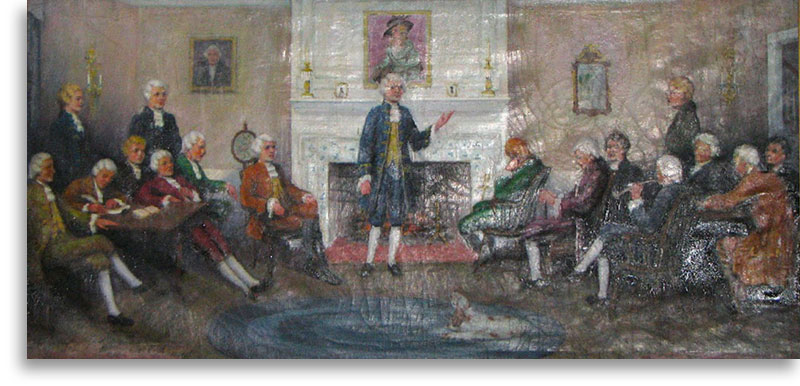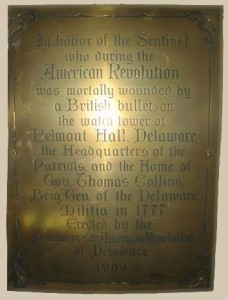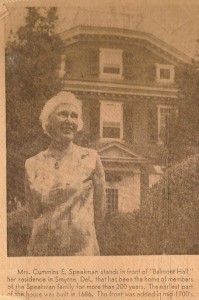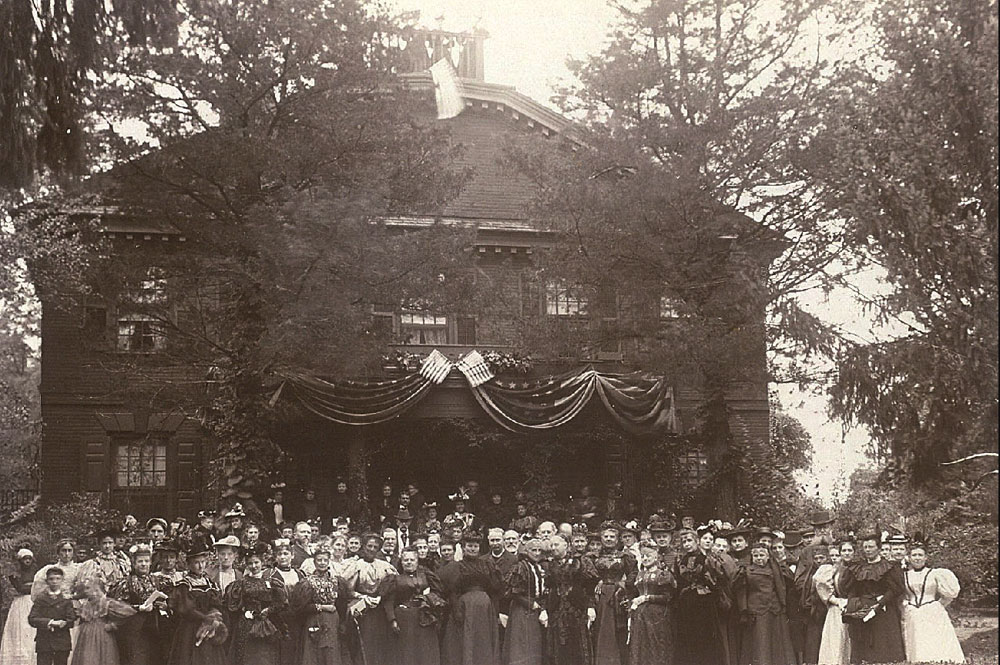The home known today as Belmont Hall is one of the most historic houses in Delaware.
 17th and early 18th centuries
17th and early 18th centuries
In 1684 William Penn granted a 600 acre parcel of land to Henry Pearman who named his property Pearman’s Choice. Thomas Collins purchased 91 ½ acres of the original grant in 1771 from John Moore. At that time there was a house on the property that was referred to as “The Manor House near Duck Creek”.
Construction of Belmont Hall
Collins finished building the Georgian house, as it stands today, in 1773 and named it Belmont Hall. Although the brickwork appears to suggest that the entire house was constructed at the same time, family history and architectural evidence indicate that Collins enlarged the dwelling by building the large front of the house. He connected the old and new parts of the house after making extensive improvements to the two older rear wings – a kitchen and a dining room with bedrooms above.
 Thomas Collins and the American Revolution
Thomas Collins and the American Revolution
Collins held almost every office in Kent County, including Sheriff from 1764-67. From 1767-69, 1772 and 1775, he served as an Assemblyman in the Delaware General Assembly which met in New Castle. In August of 1776, he went to Dover to serve in the Delaware State Constitutional Convention. After the Convention, Collins took the office of Councilman and served in this capacity for two terms from 1776-1782.
In 1776 Thomas Collins invited the Assembly (Committee of Safety) to meet at Belmont Hall since Tory and British hostilities had made it too dangerous to meet in Delaware’s first capitol city, New Castle. Thus Belmont is called the first meeting place of the Delaware Assembly (legislature).
From 1772 until the adoption of the Federal Constitution, Belmont Hall was the scene of many patriotic meetings. Caesar Rodney, Allen McLane, Col. John Haslett, Lt. Col. Charles Pope, John Dickinson, Thomas McKean, and Judge Richard Bassett were among the patriots who attended these meetings.
Collins was appointed a Lieutenant Colonel in Caesar Rodney’s Upper Kent Militia in 1775 and promoted to Brigadier General in 1776 by General Washington. Collins garrisoned his property and built a stockade around the grounds. The balustrade and tower on the top of the house were erected at his direction and used as an observation post by sentries. As a member of the Assembly, Collins agreed to raise a brigade of local militia which was maintained primarily at his own expense while the war lasted. Collins served with General George Washington in New Jersey in 1777, but returned home to contend with loyalist uprisings in Sussex County. He and his militia most likely were involved in the efforts to block General William Howell on his march from the Elk River to the Battle of Brandywine.
Thomas Collins and the State of Delaware
Collins was elected to Delaware’s 1st General Assembly where he served from 1776-1782 as Councilman. When the General Assembly moved from New Castle to Dover in 1778, he became Speaker of the Council and, again, served as Speaker from 1780-81. The only person to be unanimously elected by the Assembly, Thomas Collins had the honor of serving as the 8th President/Governor of Delaware from 1786 until his death in 1789.
When Delaware became the first state to ratify the Federal Constitution on December 7, 1787, Governor Collins was pleased to be able to certify and sign the document. Collins resided at Belmont Hall until his death on Sunday, March 29, 1789. He was the first sitting governor of Delaware to die in office.
John Cloak and Belmont Hall in the early 19th century
John Cloak (also spelled Cloke) purchased the estate in 1827 from his cousin, William Collins, Thomas Collins’ grandson. Cloak’s grandmother was Thomas Collins’ sister. John Cook, his grandfather, was the 6th Governor of Delaware and lived on large tract of land just west of Belmont Hall that had, also, been purchased from Pearman’s Choice. Cloak became interested in scientific farming, and turned his holdings into a showplace farm. His daughter, Caroline Elizabeth Cloak Peterson, inherited the estate in 1867, and continued his work.
Caroline E.C.P. Speakman and Belmont Hall in the late 19th century
Caroline Elizabeth Cloak married Howard Peterson in 1862. When he died in 1875, three of their four children had already died in early childhood. She married Gideon Speakman in 1876. A year later her only surviving child from her first marriage, Carrie Mae age 8, died. Caroline and Gideon had one son, Cummins Elliot Stockley Speakman.
Caroline began an extensive “modernization” of Belmont Hall to reflect the aesthetic of the Victorian era in the 1870’s. She painted the exterior brown, added porches, a Florida room to the dining room, and remodeled the floor plan.
From around 1895 to the 1920’s, Belmont-labeled canned tomatoes were famous for their size and tastiness. Caroline held several patents on the tomato canning process which she had developed. She also created twenty acres of gardens, installing the two boxwood formations at the front and rear of the house. Mrs. Speakman encouraged the people of Smyrna to visit the “Belmont Park and Gardens” for walks, picnics, and ice cream socials on Sunday afternoons. She also organized the Elizabeth Cook Chapter of the Daughters of the American Revolution. It was named after her great grandmother and was the second chapter formed in Delaware.
Cummins and Marjorie Speakman and Belmont Hall in the 20th century
In 1916, Cummins and his wife, Marjorie, purchased Belmont Hall from his mother. After Caroline’s death in 1920 the couple began to restore the house to its Georgian origins. Unfortunately, the house endured a devastating fire in January 1, 1922 that damaged the top two stories. Cummins and Marjorie set about the task of restoring the house with the help of friends in Wilmington, especially the DuPonts. Restoration included removing many of Caroline’s Victorian modernizations. However, the Speakmans left in place the enclosed “dog walk” between the dining room and kitchen and the hallway that was built above that enclosure to connect the rear wings’ bedrooms. The door cut through that hallway to the stair hall of the main house was also left.
Cummins and Marjorie Speakman worked tirelessly to maintain Belmont Hall. Even after Cummins’ death, Marjorie carried on their efforts. Belmont might have been sold many years earlier if it had not been for the two businesses she started in Wilmington. She treasured Belmont and its history and made sure that all of her grandchildren knew their family history and appreciated the special historic place where they grew up. She was an exceptional woman for her time. After her death in 1978, her son and daughter-in- law, Walter and Virginia Speakman resided in the house until it was sold to the State of Delaware in 1987.
Belmont Hall is on the Historic American Building Survey (HABS); is marked by a State Historic Marker, a D.A.R. plaque and is listed on The National Registry of Historic Places.

